Sustainable Industrial Revolution Starting from Hibikinada
The Fundamental Power of Hibikinada Waterfront Industrial Park
Feature PICK UP 若松を興す

Located in the northeastern part of the Hibikinada area, the 1,056-hectare Hibikinada Waterfront Industrial Park is one of the largest industrial parks in the city and is attracting attention.
The park is home to more than 100 factories and offices of major manufacturers, including Bridgestone, Toho Titanium, and Hitachi Metals, as well as logistics, recycling, and green energy-related companies, and is expected to employ some 9,700 people.
Traffic on the Wakato Tunnel and Wakato Ohashi Bridge, the main access road to the coastal industrial park, has been increasing every year since 2018, when it became free of charge, and now averages about 60,000 vehicles per day. This situation has expanded logistics and increased convenience for local residents, and has led to public-private sector collaborative projects to revitalize the town, such as a project to promote settlement in Wakamatsu for commuting workers from outside the district and factory tours in the complex for local high school students.
The Hibikinada Coastal Industrial Park is the driving force behind the revitalization of the Wakamatsu region and is the core area for the future of “Kitakyushu, the City of Manufacturing” through the fire festival at Takato-yama, the history and charm of the Wakato Bridge and Dokai Bay, and tourism development in the north coast area utilizing the magnificent scenery of Hibikinada.


The Phantom Airport Construction Project
In the early 1980s, the Hibikinada Coastal Industrial Park attracted attention as a candidate site for a new airport to replace the former Kitakyushu Airport.
This was due to the progress of large-scale reclamation projects in the Hibikinada area and the availability of a vast site. Moreover, the park was touted as an international logistics hub that would combine an airport, a port, and an industrial park, and expectations were high that it would serve as a “gateway to the sky” that would encourage the growth of local companies.
However, due to the fragility of traffic access, environmental conditions such as wind direction and weather, and differences with the national airport development policy, the plan was revised, and in 1994, when the candidate site for the new airport was officially decided as “an artificial island off the coast of Kanda Town,” the Hibikinada plan disappeared and became a “phantom plan.


Leap to a Manufacturing Base
In the 2000s, the manufacturing industry (monozukuri) in Kitakyushu City, while centered on the steel industry, became increasingly diversified, sophisticated, and environmentally oriented. As the heavy industry, which had been dominated by the steel industry, began to shrink, small and medium-sized manufacturers were required to become more sophisticated and to respond to the need for high-mix, low-volume production, and the automation of manufacturing sites, IoT, and the introduction of robots began to progress even at the small and medium-sized enterprise level.
Furthermore, as seen in the “eco-town” concept, there was a shift toward environment- and resource-recycling-oriented industries, and product development and technology exports linked to overseas markets progressed.
Under these circumstances, the Hibikinada Coastal Industrial Park was also developed based on industrial infrastructure that is said to be a remnant of the airport concept. A large container terminal with a 15-meter-deep quay wall was constructed as an international logistics hub, and an “offshore wind power zone” was established to create multiple “axes” connecting the main functions of the port.
The “sea-land logistics axis” with the base port and container terminal in the east and west areas of Hibikinada at its core, the “industrial complex axis” integrating the waterfront industrial park, eco-town area, and wind power-related industrial area, and the “energy symbiosis axis” organically linking various renewable energy supply bases and companies located in the area were developed. With the completion of the New Wakato Road (Wakato Tunnel) in 2012, the convenience of land transportation increased as the region became increasingly networked with the Higashi-Kyushu Expressway and other roads.
During this period, Bridgestone (tire manufacturing), Toho Titanium (titanium manufacturing), Nippon Coke Industry (environment and renewable energy), POSCO affiliate POS Metal (steel and materials), SK Engineering (machine tools), Amita (recycling and resource recovery), Tateho Chemical Industry (scientific materials), Fujicor ( (photocatalyst), environmental recycling-related companies, and companies participating in the Hibikinada Energy Industry Promotion Conference (renewable energy and logistics).
Various companies located in the Hibikinada Waterfront Industrial Park
The Hibikinada Coastal Industrial Park is home to a diverse range of companies in the manufacturing, environmental, energy, materials processing, logistics, and recycling industries, and has the following strengths as an industrial park
(1) It is less susceptible to recession even if a specific industrial sector suffers from it. (2) Synergistic effects among industries can be expected, as interdependence can be established even among different industries. (iii) Advanced environmental and energy fields can be secured in conjunction with the Eco-Town project and offshore wind power generation project. (iv) Advantages such as the versatility of infrastructure that can be applied in multiple industries can be pointed out.
These strengths are unique to the Hibikinada Waterfront Industrial Park, which is characterized by the diversification of industries and is more resilient to crises than industrial parks that rely on a single industrial field, enabling the park to develop as a sustainable industrial park.
From the above perspective, we would like to introduce some of the characteristic companies and organizations that make up the Hibikinada Waterfront Industrial Park.
< manufacturing industry >
Bridgestone Corporation, Kitakyushu Plant (Year of operation: 2009)
Main Products: Large and extra-large radial tires for construction and mining (OTR tires)
Features: One of the world’s leading super-large tire manufacturing bases (some products are over 4 m in diameter and 5 t in weight)
https://www.bridgestone.co.jp/corporate/outline/facilities/plant/kitakyushu.html

Toho Titanium Kitakyushu Works (Year of operation: 2010)
Main Products: Titanium sponge, titanium powder, dissolved titanium
Features: Manufacture of high-purity titanium sponge used as material for aircraft, medical equipment, and automotive parts
https://www.toho-titanium.co.jp/
< Environment-related industries >
Kitakyushu’s Eco-Town project was the first Eco-Town in Japan to be certified in 1997, and various recycling and environment-related businesses are being developed with the aim of creating a recycling-oriented society. Number of businesses: 27 businesses and 25 companies.
Kitakyushu Eco-Town Center: https://www.kitaq-ecotown.com/
Nishi Nihon PET Bottle Recycling: https://www.npr-fpco.com/
Nishi-Nippon Auto Recycle: https://warc.co.jp/
Nishi-Nippon Home Appliance Recycling: https://www.nkrc.co.jp/

< Energy related industries >
J-Power Development Co. (offshore wind power and mega solar power): https://www.jpower.co.jp/
Hibikinada Thermal Power Station (biomass): http://hibikinada.jp/
Kitakyushu Power Corporation (local production for local consumption of thermal recycled electricity): https://kitaqpw.com/


< Offshore wind power industry >
Hibiki Wind Energy Co.: https://hibikiwindenergy.co.jp/plan/









